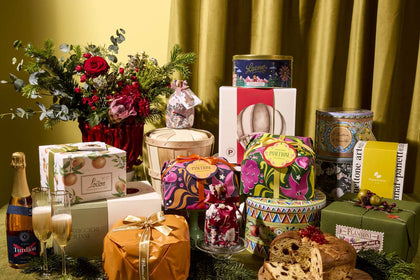All About Graham Biscuits or Graham Crackers: Best UK Alternatives
by Jannika Resido

The American Graham biscuit is world-famous. The best UK alternative is a plain digestive biscuit. Graham crackers are synonymous with the classic 'S'mores' marshmallow treat.
In this blog, we'll share absolutely everything we know about Graham biscuits, and share our thoughts on how to use them. Plus how to create a fantastic Graham cracker crust, or brilliant Graham cracker crumbs.
Shop all our biscuits here and browse baking and patisserie recipes here.
The Origins of Graham Biscuits
Graham Biscuits owe their name to a visionary individual, Sylvester Graham, an American dietary reformer in the 19th century. His advocacy for a vegetarian diet, which was high in whole grains and fibre, led to the creation of a namesake wholemeal biscuit.
Graham believed that a diet free from overly processed foods would lead to better health and morality. Despite being met with scepticism from some quarters at the time, his philosophy gained a following. The original graham biscuit was a far cry from today's sweetened versions.
They were unsweetened and coarser, made from whole grain graham flour and butter, which Graham also championed. His influence on diet and nutrition was significant, and his legacy lives on in the graham biscuits that continue to be enjoyed around the world.
The Evolution of Graham Biscuits
Over the years, graham crackers have undergone an evolution. Originally designed as a health food, they have evolved into a biscuit and ingredient in both sweet and savoury recipes.
The classic graham biscuit's texture and taste have been modified to appeal to changing consumer preferences, with manufacturers adding honey, vanilla extract cinnamon, and sugar to enhance flavour. This evolution has seen the biscuit transition from a health food to a comfort snack, often paired with tea or used as a base for desserts like cheesecakes.
Graham biscuits today are a testament to the adaptability of food products, reflecting cultural shifts and culinary innovation. As a result, they have secured their place not only in pantries around the world but also in the hearts of those who cherish this wholesome and comforting treat.
Graham Biscuits in the Victorian Era
During the Victorian era, the concept of health foods and dietary reform began to take root in society. It was within this climate that graham crackers found a receptive audience.
The Victorian focus on propriety and self-control resonated with Sylvester Graham's principles of diet and nutrition.
While Graham himself was American, his ideas crossed the Atlantic, influencing British dietetics. The simplicity and wholesomeness of graham biscuits appealed to Victorian sensibilities, which favoured modesty and restraint. These biscuits were not only seen as a means to curb excess but also as an instrument of improving one's physical well-being.
Their consumption was promoted as part of a lifestyle that shunned the excesses of the industrialised food production of the era. Graham biscuits, thus, became emblematic of a movement that sought to return to a more natural and disciplined way of life.
The Making of Graham Biscuits
Traditional Methods of Production
The production of original graham biscuits in the past was a largely manual process. Bakers mixed the graham flour by hand with milk and the other essential ingredients to form a dough.
This dough was then rolled out and cut into shapes before being baked in a moderate oven. The biscuits were often pricked with a fork to prevent them from puffing up during baking, a characteristic feature still seen in many biscuits today. The simplicity of this method ensured that the biscuits retained their homemade quality and rustic appeal. It's this traditional approach to baking that laid the foundation for the graham crackers we know today.
While modern production methods have become more sophisticated, and of course - suited to catering for huge global demand.
Graham Biscuits in American Culture
Graham biscuits are an integral part of American culture, reflecting the country's spirit of innovation and adaptation. Originating from the health movement of the 1800s, they have evolved into a versatile ingredient in the American kitchen.
Graham crackers are synonymous with the classic 'S'mores,' a campfire treat comprising roasted marshmallows and chocolate sandwiched between two graham biscuits. This iconic snack encapsulates the American tradition of outdoor adventures and family gatherings.
Beyond S'mores, graham crackers are a staple in holiday recipes and everyday snacking, often found in lunchboxes and picnic baskets.
They have a way of evoking nostalgia, reminding many Americans of childhood and simpler times. Their enduring presence in supermarkets grocery stores and homes across the country is a testament to their cultural significance and the affection they command from people of all ages.
Graham cracker crust can be seen as a base for cheesecake, in the same way that digestive biscuits are in the UK.
Other Global Variations
Graham biscuits have not only captivated American taste buds but have also found favour globally, with each region adding its own twist. In some countries, they are blended into fine crumbs to create a base for various desserts, while in others, they are dunked in chocolate or paired with fruit and cream for a quick snack.
In Asia, graham biscuits are sometimes used in layered desserts, such as mango float, which layers the biscuits with cream and fresh mangoes. Elsewhere, they are incorporated into baking mixes for breads and muffins, infusing a subtle sweetness and texture into these baked goods.
The global variations of graham crackers demonstrate their flexibility and universal appeal, as they easily meld with diverse culinary traditions. These adaptations not only keep the legacy of the graham biscuit alive but also ensure that it continues to be a cherished treat in various forms around the world.
Graham Biscuits: More than Just a Snack
Graham biscuits have transcended their role as a mere snack to become a cultural icon with various meanings and uses. They are a comfort food for many, evoking nostalgia and memories of childhood.
In educational settings, they have been used as a tool for teaching young children about cooking and nutrition. Socially, they are a staple at gatherings, contributing to the communal experience of sharing food. Graham crackers also play a role in festive traditions—during the holidays, they are used in recipes for gingerbread houses and holiday pies, becoming part of the celebratory fabric.
Their simple ingredients list and the familiarity of their taste make them a reliable and accessible option for diverse groups. The biscuit's versatility in recipes and occasions demonstrates that it is more than just a snack; it is an enduring piece of culinary culture.
Shop all our biscuits here and browse baking and patisserie recipes here.

About the author
Jannika Resido is Sous Chef's online content specialist. She is an expert in southeast Asian food and ingredients! Jannika has several years of experience writing blogs and features for online publications. She loves savoury dishes, trying new ingredients (especially the fruity ones!) and discovering recipes from across the world.


